13-21 February 2014. Wearing headlamps, we shoved our feet into our knee-high rubber boots, and following our guide and his flashlight, headed out into the nighttime jungle darkness behind the lodge. Within seconds: ‘here, come here’ he suddenly whispered and shone his beam onto the trunk of a tree. There caught in the light in full view: an enormous hairy tarantula. The real thing, all bristling black and gray and as big as your palm. Wow. Just like that we’d seen a tarantula, and not a hundred metres from where we’d be sleeping. I tried not to think about it. Suddenly, again, the whispered ‘here, come here’. This time it was a scorpion. Almost as big as your palm and with tail raised. As we continued on our guide pointed out a line of cutter ants each carrying a piece of leaf that waved above it like a green sail, and a couple of different kinds of frogs. Thus unfolded our first night of discovery in the Amazon jungle.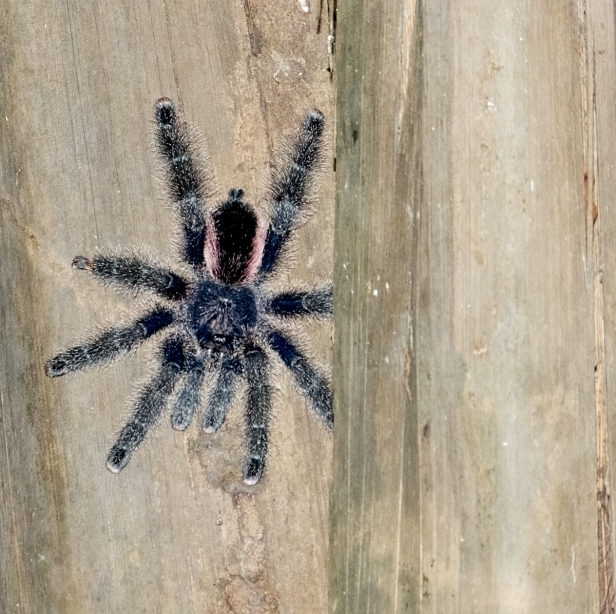
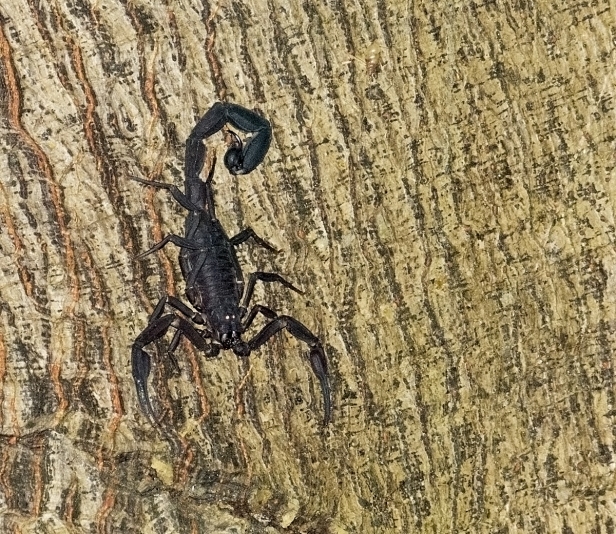
Very early that morning we’d flown from Lima to Iquitos, a town that sits on the shores of the Amazon River and is so remote it can only be reached by plane. From Iquitos we’d travelled by fast motorboat down the Amazon, and then one of its tributaries, for about three hours, finally arriving at Tahuayo Lodge. We were shown to our room, deposited our luggage, and then went to get our rabbit boots. Rabbit boots? Our guide’s thick accent and our erratic hearing meant they were ‘rabbit’ boots for the rest of our stay. After choosing the perfect boots from literally a roomful we unpacked, and then had a sumptuous meal in the dining room where we met Todd and Julie from Minnesota who were to be our travelling companions for the next eight days. And then we went out to make the acquaintance of a tarantula and a scorpion.
The mighty Amazon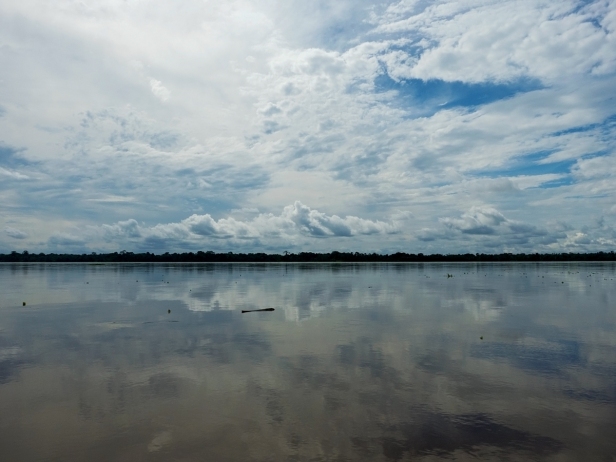
Water taxi
Tahuayo Lodge main entrance and behind it the dining hall
One of the wings of the lodge that stretches out along the river. I think our room was the left side of the central cabin in this photo. The floor and half-walls are wood and the upper walls have screening to let in the breeze (if there is any), and to keep out the bugs. I couldn’t help but be aware of some gaps in the screening. To be honest I was less afraid of tarantulas and scorpions than I was of mosquitoes. It turns out my fear was well placed, but that’s another story.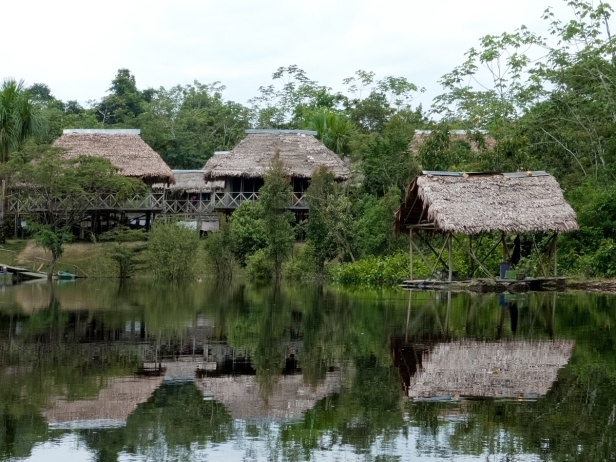
After banging our boots upside-down against the wall of the cabin to encourage any over-night visitors to leave, we pulled them on and set out again the next morning, slogging our way over the rough, tangled and swampy jungle floor. We were off on a hike for a few hours to see what we could find – me, Don, and our excellent guide Cesar.
Cesar continually amazed us with his ability to spot things hidden in the dense foliage. This mouse for instance, as big as a large rat, nestled high up a tree.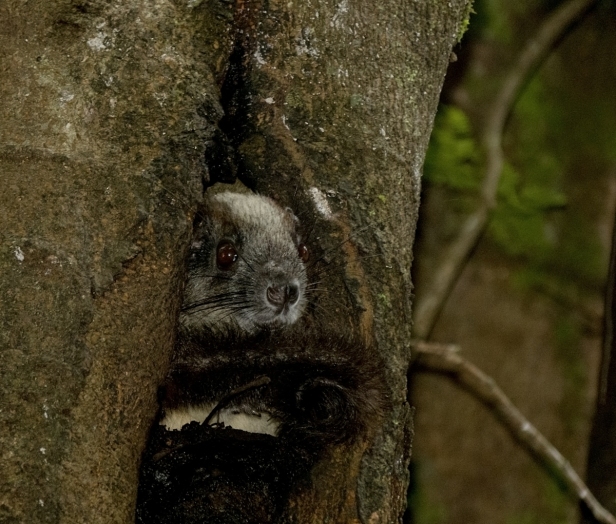
The highlights of that little trek were: the shining confident exuberance of the passionflower. Look at me!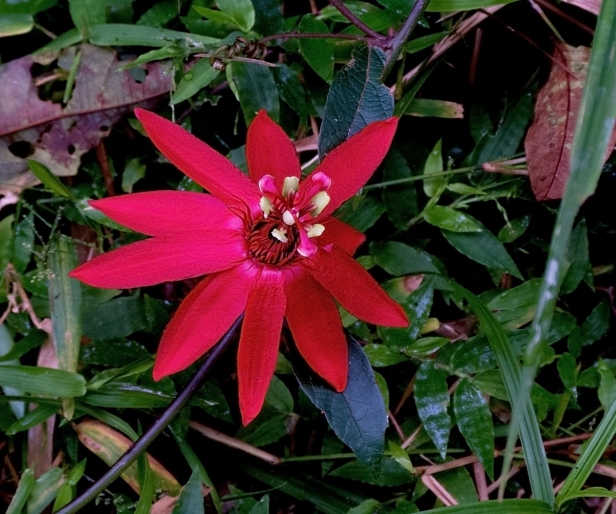
a beautifully patterned cicada,
the unexpected colours of the manakin bird,
and best of all, a tiny, shy pygmy marmoset, the world’s smallest monkey, weighing in at 100 grams (3.5 pounds).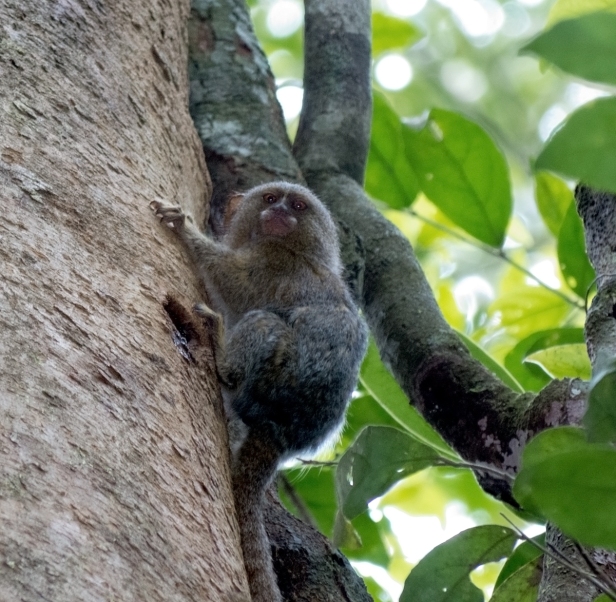
Returning to the lodge for lunch we were greeted by a tiger rat snake, not a hundred metres from the dining hall.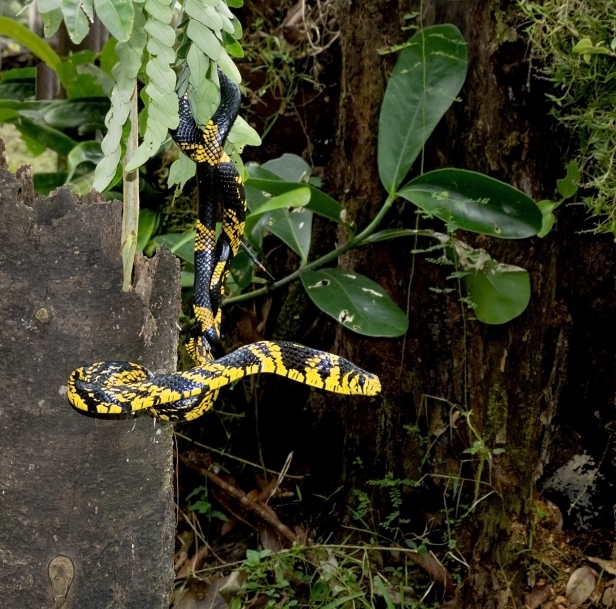
In wooden canoes we headed down the river and then turned literally right into the jungle, much of which, this far into the rainy season, is covered in water several feet deep.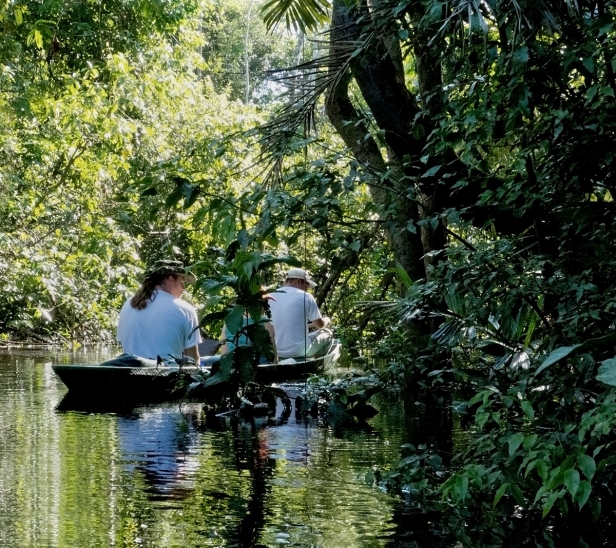
The jungle is dense. At times having to use the narrow, tightly spaced tree trunks to pull our way through we eventually emerged into a large lagoon.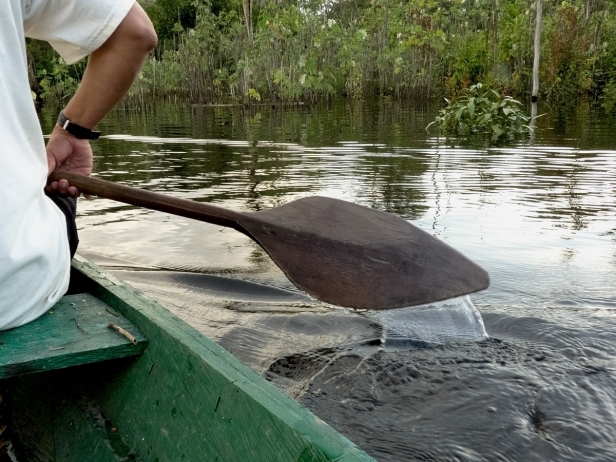
Gliding silently up and down we were looking for any signs of caiman, the prehistoric Amazon alligator. We saw signs of them aplenty; at a great distance, the telltale bumps of the two eyes barely showing above the water. Each time as we approached they disappeared.
We were awed by the silence, the stillness, the power of this immense place: vast, largely uninhabited and uninhabitable, remote, continually renewing itself over thousands of years. This existence, this earth-plants-animals-water-sun-oneness holds itself in time and space as a cohesive unit. Not one thing here survives without all the others. Not one thing moves without all the others. I think to understand the jungle may be to understand life itself.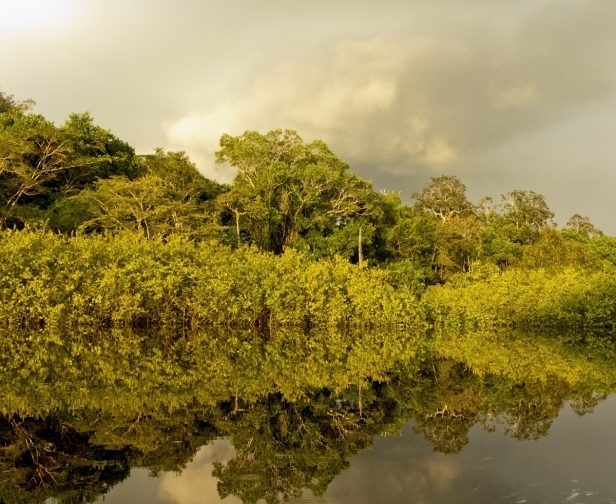
We didn’t see any caiman that day but we did see this white-eared jacamar
and a tropical kingbird.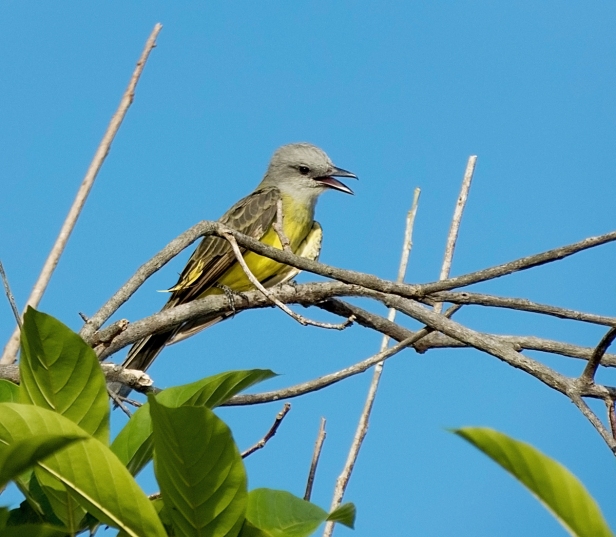
And thus our days in the Amazon unfolded. Each day we would go out morning and afternoon, either on foot, or in a boat or canoe, and explore. Oh the things we saw!
Sunrise at the lodge,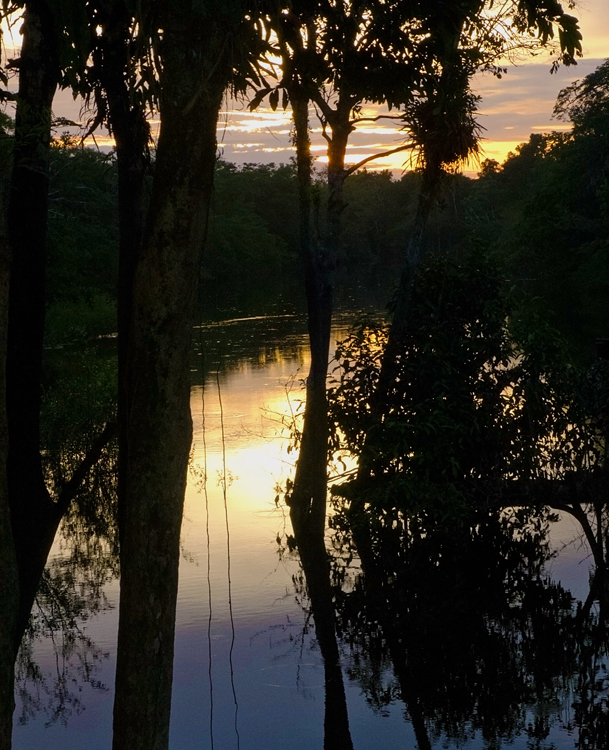
a black-collared hawk,

a brown tree frog,
yellow-headed vultures,
and this extraordinary stick insect. You would never know it was a living creature unless you saw it move.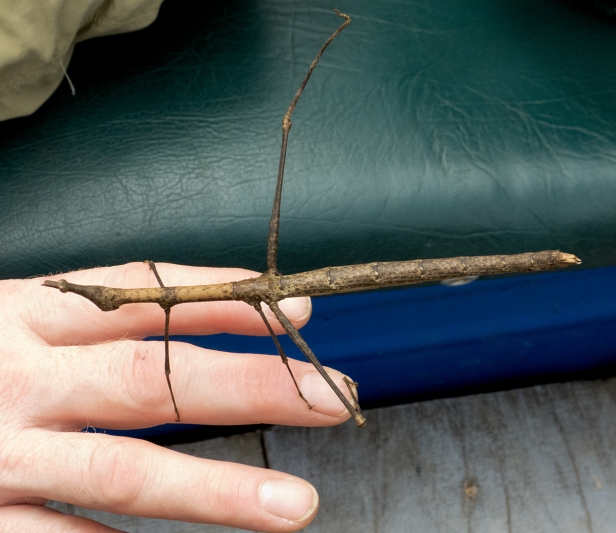
Jungle hiking is not for the unfit or the faint of heart. Hiking in rubber boots is never a comfortable exercise. The ground is uneven and will jump up and grab you at the slightest hint of a root or vine. At this time of year it is often swampy and we found ourselves oozing through thick mud that tried to suck our boots off with every step. At other times the swamp was covered in loosely placed logs and we found ourselves suddenly needing the balance of tightrope walkers to get across. Never never reach out to grab a tree if you think you’re going to fall. I did once, for the slightest balance-check, and received three bloodletting needle pricks in my palm for my trouble. Lucky it was not poisonous. A couple of jungle walking sticks were much welcomed.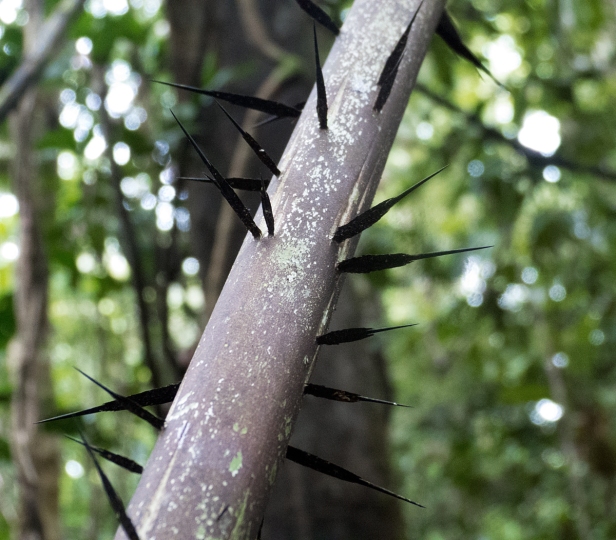
Mostly the land was flat but the area where we saw the poison-dart frogs was quite hilly. These little darlings, less than two centimetres long, are lethal to any animal that touches or eats them. The neurotoxin on their skin, which comes from the ants they eat, will kill a child, and will just about kill a grown person. The guides, though eager to show us, and make it possible for us to photograph them, were unsurprisingly very careful not to touch them, but used a leaf to maneuver them, when they could. They hopped around all over the place – the frogs, not the guides. For the guides it was just another day at the office. The traditional hunting weapon of the jungle is the blowgun. A dart is tipped with the toxin from the frog, then placed in a hollow tube and blown through it with great force. Those spikes on the tree above sure look like pretty handy darts.

We went zip lining. Finally! I’ve wanted to do this for so long. There’s a zip-line on top of Grouse Mountain near Vancouver but we never went on it. During the Olympics in Vancouver in 2010 they slung a zip-line between two skyscrapers downtown. The line-ups were – no joke – eight hours long! Can you imagine? It’s the Olympics! There is so much going. Eight hours in a line for a thirty-second ride didn’t make any sense to me.
The zip-line way back behind the lodge was worth the wait. It is about 60 metres high, way up above the jungle canopy, and has three sections ranging from 40 metres to 70 metres long. First you get strapped into your harness, and then hauled up to a platform way above in a tree. Then you’re attached to the zip-line, and sitting on the edge of the platform you launch yourself into the air. Yeah. That was a moment. It doesn’t matter that you’re harnessed in, and that you have a second safety rope attaching you to the line, there’s still that ‘what if’ fear, that part of the mind that says ‘you’re kidding right, you’re not really going to launch yourself into space right?’ And then you do it. Screaming. It was so much fun. After that first time we got quite blasé about it.
Don being hauled up to the first platform. He’s less than half way up at this point.
And zipping through the air.


This is a walking tree. Old roots rot, new ones grow, reaching down from the trunk, silently slipping gripping into new earth. In this way it walks itself slowly across the forest floor. The jungle is full of astonishments.
Before heading out in the boat one day we were given bananas to take with us to feed the moneys. We travelled a short way along the river, and around the bend and along down another smaller river. When we pulled in towards the bank there they were – three or four appropriately-named wooly monkeys waiting in the trees as if they knew; which of course they did since the guides from the Lodge had been feeding them regularly for some time. Two of them came right down onto the boat and one of them curled up in Todd’s lap, another hung from the trees, reaching down at full stretch, determined to get its share of the banana treat. We were excited to see them so close, captivated by their wooly charm.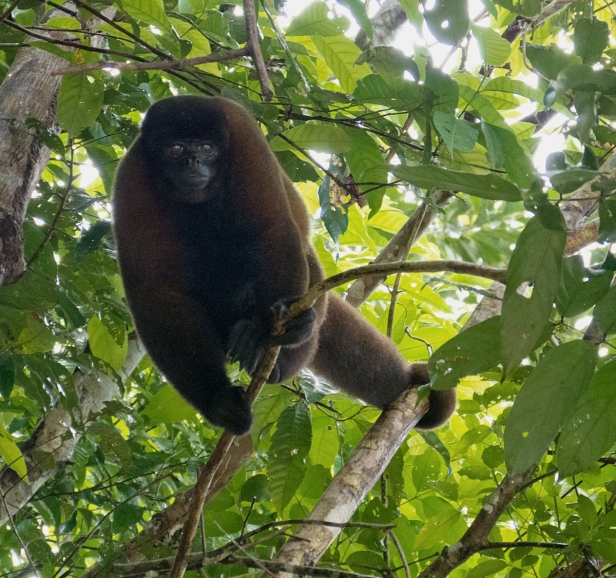


Next post: The Ribereños (people of the river), the local shaman, fierce fish, squirrel monkeys, titi monkeys, sloths, snakes, birds, bugs, bats, poisonous caterpillars, and caiman. Swimming with pink dolphins!
And fresh puma prints . . . . . .
All words and images by Alison Louise Armstrong unless otherwise noted
© Alison Louise Armstrong and Adventures in Wonderland – a pilgrimage of the heart, 2010-2015.
If you would like to stay at the same lodge contact Amazonia Expeditions. We highly recommend them. We have received no compensation for this recommendation, we just like to pass on good information.

Wow Alison. What an adventure you had in the world’s largest rain forest! I can imagine myself staying awake the whole night at that lodge just to make sure nothing creeps into the bed, or well, maybe I’ll fall asleep anyway by the sound of night critters.
I’ve never heard of that walking tree before and also the tree with those sharp black thorns! What a forest Amazon is! However seeing so many animals and plants live there shows how healthy the forest still is despite the enormous pressure to its existence.
LikeLike
It was all pretty amazing. The photo of the tree with the thorns is of one of the bigger ones. There are also trees with very thin trunks (about 3 or 4 cm diameter) that are also covered in thorns. Isn’t that walking tree incredible?! I can very vaguely remember hearing about such a thing many many years ago, but never thought I’d ever see one. Much of the forest is still healthy I believe. May it stay that way.
LikeLike
Ooooooh I never went out and about at night! What an adventure!!
LikeLike
We could have gone out every night if we’d want to, but we were too lazy. Once we’d had dinner we felt done for the day. But I certainly feel as if we got to see plenty.
LikeLike
What a life you are leading! Thank you for sharing all the wonderful photos and tales of your travels. It’s an amazing world out there.
LikeLike
Thanks Michelle. And you’re welcome, it’s fun to share. It is indeed an amazing world.
LikeLike
Sensational journey, love it. MM 🍀
LikeLike
Thanks Mick, glad you’re enjoying our adventure. Alison
LikeLike
I loved the amazon myself, just a bit on the sweaty, sticky side. 😟
LikeLike
Yes, seriously sweaty sticky. With no fans at the lodge (very restricted electricity) we were ready to go after 9 days. But it was all so worth it.
LikeLike
Likewise here, it was very primitive but well worth it – the foraging was so interesting and the butterflies out of this world. I think you saw way more mammals than we did. 👍
LikeLike
Beautiful pics, some gave me a little nostalgia as I was born in Colombia. Interesting adventure you are having. Looking forward to the next post.
LikeLike
Thank you. We never did get to Colombia 😦 ran out of time, but the northern part of South America, and Central America, are still definitely on the list.
It’s a very interesting adventure 🙂 we are very lucky. Alison
LikeLike
Thanks Alison and Don for this well written post. I love the photographs. What an adventure! I hope Don is feeling better.
LikeLike
Thank you so much. Glad you enjoyed it. Yes, it certainly is an adventure! All of it!
We’re both feeling much better. It just takes time, and paying attention to the body’s messages, and rest, which we’re getting lots of. Thanks. Alison
LikeLike
Ah Alison this has triggered some great memories for me! Such lovely vivid photos. I went into the Amazon from the jungle town of Mishuali back in 2007 – we went hunting for tarantulas one evening after dark, but instead found a nest of even larger scorpion spiders! Scary wildlife aside, it’s one of my favourite places on earth.
Thanks for sharing!
LikeLike
Thank you so much. I’m glad you enjoyed the post. Scary wildlife abounds in the Amazon no doubt, but we loved it too – such a richness of life and colour.
LikeLike
Thanks for taking us on your amazing journey. Wonderful photos as always. Love the ones of you and Don. You both look so happy and fit!
LikeLike
Thanks Helga. We were pretty happy and fit then, and having a wonderful time. It wasn’t always comfortable, but an adventure not to be missed that’s for sure.
LikeLike
Incredible photos and experience! I can only imagine the feeling of the immensity of nature here in what you describe as the stillness and silence.
LikeLike
Thanks Angeline. Oh it was an amazing experience! We wouldn’t have missed it for anything even if it was challenging at times. The immensity of nature is overpowering there: it’s so dense and intense and rich.
LikeLike
grateful for your witnessing
the deep, dark, bright beautiful
jungle and all it’s life forms!
LikeLike
Thank you so much for this beautiful haiku. Grateful for your appreciation, and for our adventure in the jungle.
LikeLike
I like this insight and how you express it: “This existence, this earth-plants-animals-water-sun-oneness holds itself in time and space as a cohesive unit. Not one thing here survives without all the others. Not one thing moves without all the others. I think to understand the jungle maybe to understand life itself.”
LikeLike
Thanks Kate. It felt like that – a cohesive unit, dense and intense and somehow impenetrable even though we were in it. There’s a power there that’s hard to explain.
LikeLike
You make me want to travel,or indeed to bask more in my adventurous side and hold a camera on my journey.Lovely work.:)
LikeLike
Thank you so much Laurna. I’m glad you enjoyed it. Grab your camera and go be adventurous! 🙂
LikeLike
You are welcome,I will,i promise,and i will post so you guys can see.:)
Regards
Laurna
LikeLike
You make me want to pack my bags and go there immediately, but through your beautiful photography and lovely narrative, I feel I’ve already been. 🙂 Great post!
LikeLike
Thank you so much. It’s lovely to hear you felt as if you were there. It’s a really amazing place – maybe you’ll go one day.
LikeLike
Gosh, you two are fearless, the water taxi alone seems like an adventure! Iquitos–another destination to add to our RTW wish list. As always, loved your photos.
LikeLike
Thanks so much. Oh yes do go to the Amazon – go further than Iquitos – that’s just the jumping off point and not a very attractive town. We weren’t actually on the water taxi though we’ve been on something similar in other places.
LikeLike
Great post! Thanks!
LikeLike
Thanks so much Natalie, and you’re welcome. Glad you enjoyed it.
LikeLike
First…jealous…truly. Except for the part about all the crawly things, although we have scorpions here, so that’s old hat, but giant hairy spiders? We don’t see those as much; even they have standards and won’t put up with a Phoenix summer. I am DYING to hear about the pink dolphins…
LikeLike
You should go there! Crawly things were okay – they didn’t bother us anyway. I think they’re actually quite shy. It’s as hot and humid as a Phoenix summer. Sticky, but worth it. Pink dolphins coming soon. No pics of the though.
LikeLike
Oh wow, I was so thrilled to read about your adventure in the Amazon. We spent 8 days at Tahuayo Lodge and the ARC back in November, and did everything you have written about here. This brought back some amazing memories! Amazonia Expeditions is the BEST for experiencing the jungle of northern Peru! But I have never been able to put the experience into words as wonderfully as what you did here – thank you for that! Going to the Amazon was my bucket list trip and I loved every sweaty bug-bitten heat-rash minute of it, truly! … I am looking forward to your next post, and reading about your other adventures :-).
LikeLike
Hi Lisa, thank you so much for your lovely compliments. Isn’t the Amazonia Expeditions experience fabulous?! We too loved every sweaty bug-ridden heat-rash minute of it. The Amazon jungle is an extraordinary place. We wouldn’t have missed it for anything.
I LOVE your paintings! They so beautifully capture that northwest landscape.
LikeLike
Great post and terrific photos. We’ll be in Ecuador for a few months beginning in September (finally!) and your stories are both whetting our interests and our imaginations! Anita
LikeLike
Thanks Anita, glad you enjoyed it. We’d run out of energy a bit by the time we got to Ecuador but there’s lots to do and see there. It’s definitely possible to go into the Amazon from Ecuador, but I have no idea if it’s better to go from Ecuador or Peru. Or Brazil for that matter. Anyway you’ll find your own adventures there. Alison
LikeLike
Alison, this gorgeous post is simply brimming with life and colour; thanks to your photos and vivid descriptions I can almost hear the sound of all those frogs and insects! What a gift it must have been to stay in the Amazon for eight days… reading your account makes it clear just how special the rainforest is. I hate the fact that vast tracts of jungle around the world are being mindlessly destroyed this minute – for cash crops and the scourge that is palm oil.
LikeLike
Thank you so much James. It was indeed a gift to be there – a truly extraordinary time. I share your sadness/anger re the rain forests. I’m always signing petitions in the hope of improving things.
LikeLike
The monkeys are so fuzzy!!! These pictures are absolutely amazing… it sounds like you guys had a pretty brilliant experience, too. 🙂
LikeLike
Thanks Rara. Cute monkeys eh?! And yes, we had a brilliant experience – really out of this world.
LikeLike
hi im winny from indonesia. i really like ur adventure, it is amazing and a bit envy because u can visit Amazone
LikeLike
Thanks so much winny. I’m glad you enjoyed the post, and I hope you get to the Amazon one day. Alison
LikeLike
Wow! What an adventurous trip! I enjoyed reading it. And the pictures are stunningly beautiful. I envy you 😉 thanks for sharing your experience.
LikeLike
Thank you so much, and you’re very welcome. I’m glad you enjoyed the post. It was definitely an adventure!
LikeLike
my aim Alison 🙂
LikeLike
“Not one thing here survives without all the others. Not one thing moves without all the others. I think to understand the jungle maybe to understand life itself.” I really love this observation. It can be so easy to forget that we somehow “arise together” as beings even. I think I read once about a Buddhist notion of mutual arising, but I cannot remember it well enough to say anything other than the obvious, and yet it has always struck me as being true, and a beautiful thought.
This type of observation closes the door on the notion that anything exists unto itself alone. Even in physics, I think it is the case that particles derive their properties from their interactions with those near them, and from space itself.
The walking tree blew my mind, as did many of the photos. Life has so much to offer. It is simply amazing.
Michael
LikeLike
It felt so strongly to me that it was all of a piece, arising together. I think everything is arising together, but with the jungle I could really feel it, this unique oneness, this inseparability.
Yes, I too was rather taken with the walking tree. Wow! Would not have thought such a thing would exist, or tiny colourful frogs that can kill you at touch. The jungle is full of astonishments.
Thanks re the photos.
Alison
LikeLike
Wow, you have me re-living our Amazon Riverboat experience… so unique, so amazing. I think we forget what Real Nature is after living in cities for a long time.
LikeLike
Oh you’ve been there! So you know what it’s like – not enough superlatives to describe it. I agree we forget, living in the cities, what real nature is like. I get to long for it after a while.
LikeLike
Wonderful photos, Alison! It brings back so many vivid memories. You captured some amazing moments and incredible wildlife shots!
LikeLike
Thanks Naomi, I thought it might bring back memories for you. You went to the same place didn’t you? Anyway thanks for your nice words. Alison
LikeLike
After a few weeks, I’m just catching up on your latest travels. You’ve been to some amazing places, but this seems the most amazing and foreboding, with the threat of poison, sharp spines, and killer beasts. What a great adventure, and beautiful photos, too. I’m surprised you could get such good close-ups of the birds and other small animals.
LikeLike
Thanks Frank. Yes, it was a great adventure, and we never felt unsafe. Well I did occasionally have thoughts at night about one of those hairy tarantulas crawling into our room, but then I’d forget about it and go to sleep. During the day we were always with an experienced local guide who we trusted completely. My camera has an okay zoom lens. Honestly I’m looking to upgrade. The camera I have is not good in low light, and I took many photographs in the jungle that were too grainy or out of focus, though I’m happy I got some okay shots. Some surprising ones too – that ended up being much better than I expected.
LikeLike
That was riveting and every bit as adventurous and exciting as I was imagining it to be.
The photos: incredible. You have a real gift for capturing the moment.
The wildlife you saw: unbelievable! That is truly an experience of a lifetime right there.
The photos of your zip lining experience are just amazing. I can’t even begin to imagine how wonderful the feeling of flying over the Amazon would be.
This is one place that I’d love to see, BUT I’m so scared of spiders, scorpions, frogs…things of that nature…I’m not so certain I could do it. I’ll have to start smaller, I think, work my way up to this.
A truly amazing adventure you guys! Trees with spikes, poisonous frogs and welcoming monkeys. Truly wondrous!
One of my favorite posts thus far, definitely sharing this with Matt, he’s going to love it!
~ Andrea ❤
LikeLike
Thank you so much Andrea for all your wonderful compliments! It truly was the experience of a lifetime, an adventure we wouldn’t have missed for anything.
Having grown up in Australia where there is an abundance of poisonous snakes and spiders I suppose I’m a bit (but not completely) blasé about such things. I think it helped.
LikeLike
Reblogged this on Cristian Mihai.
LikeLiked by 1 person
Thanks Cristian.
Alison
LikeLike
Great photos and writing, amazing stuff you could hardly even invent (like the walking trees, unless you’re talking hobbits and Middle Earth!).
Thanks for sharing, although I confess the snakes scare the bejaysus out of me!
LikeLiked by 1 person
Thank you so much. Oh the jungle was full of astonishments – walking trees, tiny frogs covered in poison slime. I found out the hard way that there are 147 different mosquito-borne viruses in the Amazon! Anyway I’m fine now, and the adventure was definitely worth it. Snakes don’t bother me – perhaps because I grew up in Australia. In the other post about the Amazon there’s a photo of an an emerald tree boa – beautiful colours.
Alison
LikeLiked by 1 person
In Ireland, they got rid of the snakes (but forgot the politicians 😉 )…
Thanks, I’ll go check out the emerald tree boa right now
LikeLiked by 1 person
Wow! Thank you so much for sharing Life in action! Love it!
LikeLiked by 1 person
Thank you! And you’re welcome. I’m glad you enjoyed it.
Alison
LikeLike
I just returned from a month in the jungle, on the Amazon from Iquitos. I stumbled upon your blog and was immediately filled with love and joy for all the wonderful healing that the jungle provides! Great photos, it brought me right back!
LikeLiked by 1 person
Thank you so much. I’m so glad this brought back some good memories for you. We had an amazing time there – such a rich soulful environment.
Alison
LikeLike
Reblogged this on quirkywritingcorner and commented:
This was reblogged by Christian Mihal, but for unknown reasons the photos did not show up. Luckily, they appeared on the original site. They are gorgeous and I would have hate to miss them.
LikeLiked by 1 person
Thank you so much!
Alison
LikeLike